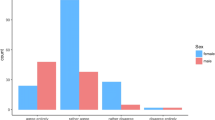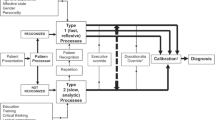Abstract
Background
Inattention blindness (IB) can be defined as the failure to perceive an unexpected object when attention is focussed on another object or task. The principal aim of this study was to determine the effect of cognitive load and surgical image guidance on operative IB.
Methods
Using a randomised control study design, participants were allocated to a high or low cognitive load group and subsequently to one of three augmented reality (AR) image guidance groups (no guidance, wireframe overlay and solid overlay). Randomised participants watched a segment of video from a robotic partial nephrectomy. Those in the high cognitive load groups were asked to keep a count of instrument movements, while those in the low cognitive load groups were only asked to watch the video. Two foreign bodies were visible within the operative scene: a swab, within the periphery of vision; and a suture, in the centre of the operative scene. Once the participants had finished watching the video, they were asked to report whether they had observed a swab or suture.
Results
The overall level of prompted inattention blindness was 74 and 10 % for the swab and suture, respectively. Significantly higher levels of IB for the swab were seen in the high versus the low cognitive load groups, but not for the suture (8 vs. 47 %, p < 0.001 and 90 vs. 91 %, p = 1.000, for swab and suture, respectively). No significant difference was seen between image guidance groups for attention of the swab or suture (29 vs. 20 %, p = 0.520 and 22 vs. 22 %, p = 1.000, respectively).
Conclusions
The overall effect of IB on operative practice appeared to be significant, within the context of this study. When examining for the effects of AR image guidance and cognitive load on IB, only the latter was found to have significance.

Similar content being viewed by others
References
Mack A, Rock I (1998) Inattentional blindness, 1st edn. MIT Press, Cambridge
Simons DJ, Chabris CF (1999) Gorillas in our midst: sustained inattentional blindness for dynamic events. Perception 28:1059–1074
Dixon BJ, Daly MJ, Chan H, Vescan AD, Witterick IJ, Irish JC (2013) Surgeons blinded by enhanced navigation: the effect of augmented reality on attention. Surg Endosc 27:454–461
Williams LJ (1982) Cognitive load and the functional field of view. Hum Factors J Hum Factors Ergon Soc 24:683–692
Fadden S, Wickens CD, Vevers P (2000) Costs and benefits of head up displays: an attention perspective and a meta analysis. World Aviat Congr
Fischer E, Haines R (1980) Cognitive issues in head-up displays. NASA Tech Pap 1711
Mccann RS, Foyle DC (1993) Attentional limitations with heads up displays. In: Jensen R (ed) Proceedings of Seventh International Symposium. Aviat Psychol. pp 70–75
Cartwright-Finch U, Lavie N (2007) The role of perceptual load in inattentional blindness. Cognition 102:321–340. doi:10.1016/j.cognition.2006.01.002
Hughes-Hallett A, Mayer EK, Marcus HJ, Cundy TP, Pratt PJ, Parston G, Vale J, Darzi AW (2014) Quantifying innovation in surgery. Ann Surg 260:205–211
Pratt P, Mayer E, Vale J, Cohen D, Edwards E, Darzi A, Yang G-Z (2012) An effective visualisation and registration system for image-guided robotic partial nephrectomy. J Robot Surg 6:23–31
Hart S, Staveland L (1988) Development of NASA-TLX (task load index): results of empirical and theoretical research. In: Hancock A, Meshkati N (eds) Human Mental Workload. North Holland Press, Amsterdam, pp 139–183
Healey AN, Sevdalis N, Vincent CA (2006) Measuring intra-operative interference from distraction and interruption observed in the operating theatre. Ergonomics 49:589–604
Guru KA, Esfahani ET, Raza SJ, Bhat R, Wang K, Hammond Y, Wilding G, Peabody JO, Chowriappa AJ (2014) Cognitive skills assessment during robot-assisted surgery: separating wheat from chaff. BJU Int 115:166–174
Wickens CD, Alexander AL (2009) Attentional tunneling and task management in synthetic vision displays. Int J Aviat Psychol 19:182–199
Liu D, Jenkins SA, Sanderson PM, Watson MO, Leane T, Kruys A, Russell WJ (2009) Monitoring with head-mounted displays: performance and safety in a full-scale simulator and part-task trainer. Anesth Analg 109:1135–1146
Bressan P, Pizzighello S (2008) The attentional cost of inattentional blindness. Cognition 106:370–383
Lavie N (2005) Distracted and confused?: selective attention under load. Trends Cogn Sci 9:75–82
Disclosures
Archie Hughes-Hallett, Erik Mayer, Hani Marcus, Philip Pratt, Sam Mason, Ara Darzi, and Justin Vale have no conflicts of interest or financial ties to disclose.
Author information
Authors and Affiliations
Corresponding author
Rights and permissions
About this article
Cite this article
Hughes-Hallett, A., Mayer, E.K., Marcus, H.J. et al. Inattention blindness in surgery. Surg Endosc 29, 3184–3189 (2015). https://doi.org/10.1007/s00464-014-4051-3
Received:
Accepted:
Published:
Issue Date:
DOI: https://doi.org/10.1007/s00464-014-4051-3




